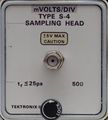S-4: Difference between revisions
No edit summary |
|||
| Line 26: | Line 26: | ||
==Internals== | ==Internals== | ||
The S-4 sampling gate is based upon a traveling wave trapped-charge transmission line in which the sampling window is set by the propagation time of a pulse edge through a thick-film transmission line. This technique requires only a sharp pulse edge rather than a precise pulse width, which is harder to generate. | The S-4 sampling gate is based upon a traveling wave trapped-charge transmission line | ||
in which the sampling window is set by the propagation time of a pulse edge through a thick-film transmission line. | |||
This technique requires only a sharp pulse edge rather than a precise pulse width, which is harder to generate. | |||
The sampling diodes are housed in a special coaxial connector that provides a high bandwidth signal path. | The sampling diodes are housed in a special coaxial connector that provides a high bandwidth signal path. | ||
To disassemble the sampler hybrid, first remove it from the sampler board as per the manual. | To disassemble the sampler hybrid, first remove it from the sampler board as per the manual. | ||
connector using a 7/32" wrench and remove the 20 dB attenuator with small | Remove the input connector using a 7/32" wrench and remove the 20 dB attenuator with small pliers. | ||
to the housing using roll pins that can be pressed out with a 0.030" pin punch. | The ceramic board is held to the housing using roll pins that can be pressed out with a 0.030" pin punch. | ||
each about 0.75mm square. | The hybrid has six diodes, each about 0.75mm square. | ||
are wire-bonded (twice) over a gap to the next step in the strobe line. | The cathodes are glued to the gold substrate with conductive epoxy and the anodes | ||
diode may fit across the gap but cleanly removing a failed diode without damaging the substrate would be | are wire-bonded (twice) over a gap to the next step in the strobe line. | ||
quite difficult. | It appears that a standard beam-lead diode may fit across the gap | ||
but cleanly removing a failed diode without damaging the substrate would be quite difficult. | |||
==Links== | ==Links== | ||
Revision as of 10:06, 27 December 2017
Template:Plugin Sidebar 2 The Tektronix S-4 is a sampling head for 7000- and 3S-series samplers. It was designed by George Frye and introduced in 1968. It is the fastest of the S-series plug-in samplers.
Key Specifications
| Rise time | 25 ps (observed with S-50 or S-52, 35 ps) |
|---|---|
| Bandwidth | 14.5 GHz |
| Input impedance | 50 Ω (terminated SMA connector) |
| Input range | operating, 1 Vp-p; max. safe overload, ±5 V |
| Noise | < 5 mV |
| Features |
|
Internals
The S-4 sampling gate is based upon a traveling wave trapped-charge transmission line in which the sampling window is set by the propagation time of a pulse edge through a thick-film transmission line. This technique requires only a sharp pulse edge rather than a precise pulse width, which is harder to generate. The sampling diodes are housed in a special coaxial connector that provides a high bandwidth signal path.
To disassemble the sampler hybrid, first remove it from the sampler board as per the manual. Remove the input connector using a 7/32" wrench and remove the 20 dB attenuator with small pliers. The ceramic board is held to the housing using roll pins that can be pressed out with a 0.030" pin punch. The hybrid has six diodes, each about 0.75mm square. The cathodes are glued to the gold substrate with conductive epoxy and the anodes are wire-bonded (twice) over a gap to the next step in the strobe line. It appears that a standard beam-lead diode may fit across the gap but cleanly removing a failed diode without damaging the substrate would be quite difficult.
Links
- S-4 page @ amplifier.cd
- James R. Andrews, Comparison of Ultra-Fast Rise Sampling Oscilloscopes. Picosecond Pulse Labs App Note AN-2a, 1989











